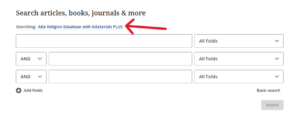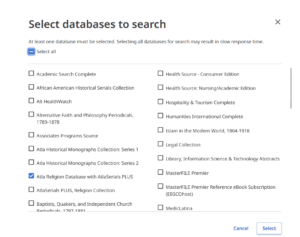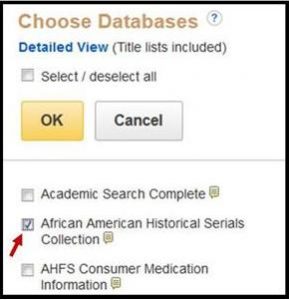How to change or combine databases
Almost everyone looking for these research tools will start from our Library homepage, and then click on Online Databases, under the LIBRARY RESOURCES tab. Our homepage is the hub for all of the electronic information we make available to our users.
Once you have opened one of the EBSCO databases and started using it, you might decide to move to another and find out what that one has to offer on your topic. Or, you might like to select several of them and search them at the same time. To do this, first click the name of the database you are currently searching.
You receive a dialogue box showing all of the online databases to which we subscribe from this vendor. We list only the most heavily used resources on our Online Databases page, but as you can see, there are many more available in other disciplines and subject areas. Feel free to explore any of these. If your research interests overlap from the traditional religious studies areas into social science, medicine, humanities, etc., these resources could be most helpful.
Click in the little box beside each database you want, and then click on the button marked Select.
The "Choose Databases" link
Once you have opened one of the EBSCO databases and started using it, you might decide to move to another and find out what that one has to offer on your topic. Or, you might like to select several of them and search them at the same time. Look for the small link saying Choose Databases in the search box near the name of the resource you are using.
Click on that link. You receive a dialogue box showing all of the online databases to which we subscribe from this vendor. We list only the most heavily used resources on our Online Databases page, but as you can see, there are many more available in other disciplines and subject areas. Feel free to explore any of these. If your research interests overlap from the traditional religious studies areas into social science, medicine, humanities, etc., these resources could be most helpful.
Click in the little box beside each database you want, and then click on the button marked OK.
You will return to the search screen, where you can proceed with your work. If you want to see which databases are now included in your searching, click on the little link that says Show all.
PLEASE NOTE : There is an important consideration to think about when you are using more than one database at a time. Though they appear similar, the various EBSCO databases actually have different search capabilities. For example, the ATLA-RDB/ATLAS is the only resource that provides the “Hierarchical Scripture Authority” method of searching for specific passages of Scripture. So, if you try to use that feature while combining databases, the interface will break up your Scripture searching into separate headings and force you to choose them one at a time.
However, if you are doing a type of search that all of your databases share in common — an Author or Subject search, for instance — it will be able to query all of the resources at once and return a single set of results.





